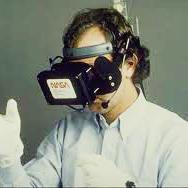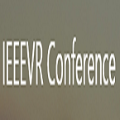Exploring large virtual environments, such as cities, is a central task in several domains, such as gaming and urban planning. VR systems can greatly help this task by providing an immersive experience; however, a common issue with viewing and navigating a city in the traditional sense is that users can either obtain a local or a global view, but not both at the same time, requiring them to continuously switch between perspectives, losing context and distracting them from their analysis. In this paper, our goal is to allow users to navigate to points of interest without changing perspectives. To accomplish this, we design an intuitive navigation interface that takes advantage of the strong sense of spatial presence provided by VR. We supplement this interface with a perspective that warps the environment, called UrbanRama, based on a cylindrical projection, providing a mix of local and global views. The design of this interface was performed as an iterative process in collaboration with architects and urban planners. We conducted a qualitative and a quantitative pilot user study to evaluate UrbanRama and the results indicate the effectiveness of our system in reducing perspective changes, while ensuring that the warping doesn't affect distance and orientation perception.
翻译:探索大型虚拟环境(如城市)是多个领域的中心任务,例如游戏和城市规划。 VR系统可以通过提供亲身体验,大大帮助这项任务;然而,从传统意义上看和浏览一个城市的一个共同问题是,用户既可以获得当地或全球观点,但不能同时同时获得,要求用户在观点之间不断转变,失去背景,并分散对城市的分析。在本文件中,我们的目标是让用户在不改变观点的情况下浏览感兴趣的点。为实现这一目标,我们设计了一个直觉导航界面,利用VR提供的强烈空间存在感。我们用一种观点来补充这一界面,即根据圆柱形预测对环境进行扭曲,称为 " UrbanRama ",提供当地和全球观点的组合。这一界面的设计是与建筑师和城市规划者合作进行的一个互动过程。我们进行了一个定性和定量的试点用户研究,以评估城市地图和结果,以显示我们的系统在减少观点变化方面的有效性,同时确保扭曲的扭曲不会影响距离和方向。




